2012-2017: on all fronts to achieve peace

In Iraq, Syria, Sahel, the Gulf of Guinea and Somalia, with a UN mandate and acting alongside its NATO or EU partners, France mobilises troops, material and equipment to carry out peacekeeping or humanitarian missions, fight terrorism or protect French nationals. Part of our history, French overseas operations continue to make the headlines today.
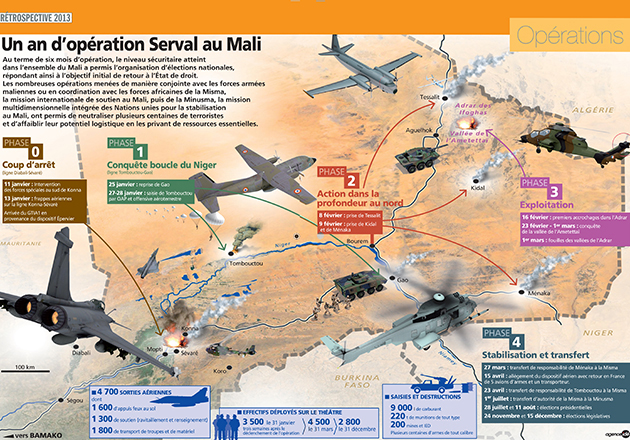
Looking back on one year of Operation Serval in Mali, 2013. Infographic © DICOD/IDIX
The outlook in 2012 was of a pause in operations. Having returned from operations in Libya and Côte d'Ivoire, the French armed forces were preparing to withdraw their military capability from Afghanistan, a decision announced by both candidates in the presidential elections and confirmed in May, in Kabul, by President François Hollande.
The strategic disruptions of the following years contradicted these intentions. The mounting pressure of terrorism, threats to national interests and humanitarian crises led to unprecedented involvement of the armed forces, in demand on all fronts and across nearly their entire range of capacities. From France to Sahel to the Levant, never before had the armed forces seen such a high level of involvement. The protection of France and French citizens was now played out both overseas, at proximity to the trouble spots, and on national territory and its immediate vicinity.
Fighting armed terrorist groups in Sahel
On 11 January 2013, the jihadists installed in northern Mali began to make progress towards Bamako. At the request of the Malian government, France launched its first actions, consisting of an intervention by Gazelle helicopters of a detachment of special forces pre-positioned in Burkina Faso. They brought about an initial halt, which was completed on the ground in the Mopti and Sevare sector. Very rapidly, aircraft stationed in Chad, then Rafales from metropolitan France, launched air strikes to contain the jihadists' movements.
Then, deployed from Côte d'Ivoire, Chad, and France, where the Guépard warning mechanism had been activated, French troops were mobilised in Operation Serval. Heading north from Bamako and Niamey, their offensives converged to reconquer Mali as far as its northern borders. Gao was recaptured on 26 January, Timbuktu on the 28th. The fighting then continued in the Adrar des Ifoghas massif, a refuge for terrorist groups.
By summer 2013, it had become apparent that intervention beyond the limits of Mali was needed and that a new approach must be taken to confront the terrorist threat which, in these desert areas, easily crossed practically unpoliceable borders. Only a regional approach could tackle the ramifications of the terrorist organisation and counter these cross-border movements in the Sahel-Sahara belt. Greater coordination was needed between the countries that now comprised the G5 Sahel (Mauritania, Mali, Burkina Faso, Niger and Chad), while the fighting against the armed terrorist groups continued.
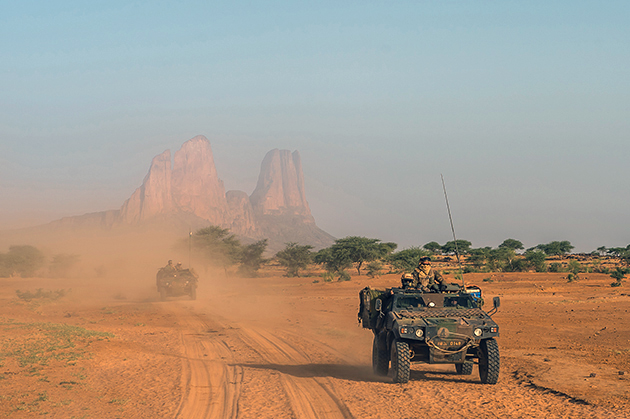
Operation Barkhane, Chad, 2014. © G. Guesquière/Armée de Terre
Representing the military component of this approach, Operation Barkhane succeeded Serval on 1 August 2014. Fully involved in an operational military partnership with the armed forces of the G5 Sahel, French troops now participated in a dynamic operation to seek out the terrorists and to support the rebuilding of the Malian army.
Ever more mobile, the Barkhane force continues to carry out its actions in the Sahel-Saharan belt today. As well as standing alongside the armed forces of the G5 Sahel countries to counter the armed terrorist groups' attempts to reorganise, its action focuses on providing backup and support to its partners, while always ensuring they are making a difference for local people.
Fighting in a coalition: Operation Chammal in the Levant
On 29 June 2014, the terrorist group IS left the international community stunned. After a lightning advance which routed the Iraqi army and saw cities like Manbij in Syria and Fallujah in Iraq fall into the hands of the jihadists, the religious leader Abu Bakr al-Baghdadi proclaimed from Mosul the constitution of a caliphate across the territories of Iraq and Syria.
Faced with this threat, the international community launched Operation Inherent Resolve (OIR), involving over 60 nations. This ad hoc coalition, in which France was the number-two contributor, was commanded from Kuwait, with a command and coordination centre for air operations located in Qatar. Launched on 19 September 2014 at the request of the Iraqi government and in coordination with France's allies with a presence in the region, Operation Chammal was the French component of OIR.
Chammal was initially based on two complementary approaches: destroy IS's capability in Iraq by means of air strikes, and help build up local forces that would engage in fighting on the ground to recapture their own territory. Initially limited to Iraq, in September 2015 the operation zone was extended to Syria, where IS was also active and where those behind the terrorist attacks in France and Europe were located.
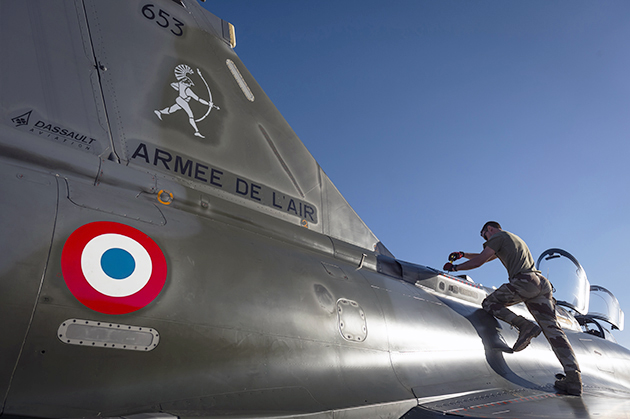
Arrival and change of configuration of relief aircraft, Operation Chammal. © C. Patenaire/Armée de l'Air/Défense
The strikes were carried out from the air, by a ”support” column developed at the French base in the United Arab Emirates, subsequently reinforced by the construction of an airbase in Jordan in December 2014. It was the air force's task to dismember the IS network, by depriving it of its command, logistics and training capabilities, as well as its capacity to put together an arsenal of improvised explosive weapons. Operating within the coalition, the airmen and women made either planned strikes on military targets properly identified through meticulous intelligence, or strikes in direct support of ground forces as they progressively recaptured their cities. On three occasions, they received backup from the naval air force, with the deployment of the aircraft carrier Charles de Gaulle close to the theatre of operations.
In the vicinity of Baghdad, French instructors were deployed within the Narvik and Monsabert task forces to provide direct support to the Iraqi Counter-Terrorism Service (CTS), an elite unit that would launch the offensives ahead of the Iraqi forces, and the 6th Iraqi Infantry Division in charge of protecting Baghdad. In a more discreet capacity, special forces were deployed in Iraqi Kurdistan to train then support the peshmergas in their operations. When Mosul was recaptured in autumn 2016, the scope of their activities was extended to include the CTS.
At this stage, the Chammal force was joined by French artillery. Deployed in the Mosul area with their Caesar howitzers, they provided direct support to Iraqi forces to recapture the city, starting with the western half, liberated in early 2017.
In 2016, IS lost nearly of its cities, except Mosul and Raqqa, emblematic cities where the terrorist group had imposed its regime and staged its acts of violence. France contributed directly to the successes of local forces, making over 7 000 air sorties in May 2017, destroying 2 000 targets with air strikes and carrying out more than 1 200 artillery missions.
Stabilising and supporting the deployment of a peacekeeping force: Operation Sangaris
In December 2013, after a year of turmoil in the Central African Republic, the situation became a humanitarian crisis. Acts of violence against the civilian population increased. Non-governmental organisations reported looting and human rights abuses. In addition to these acts, a sectarian conflict was emerging.
In view of the urgency of the situation, France proposed Operation Sangaris, which it then launched with a UN mandate. On entering the theatre of operation, the French troops went straight to the aid of the people under threat, in Bangui to begin with, then in the countryside.
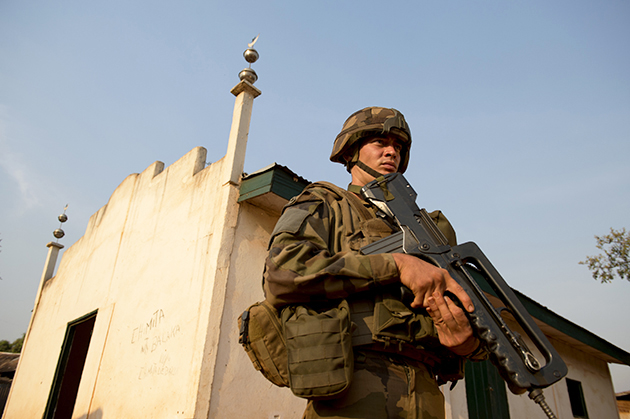
Operation Sangaris. © J. Lempin/ECPAD/Défense
In early summer 2014, with the deployment of over 2 000 French troops, a level of security was attained. This meant that the international MINUSCA force could be deployed progressively throughout the country. The Sangaris force then focused on the most sensitive areas.
At the beginning of 2015, the improved security situation meant that the government of the Central African Republic was able to launch a national reconciliation initiative and gradually reassert authority over its territory. As of 1 July 2015, there were approximately 900 troops deployed on Operation Sangaris, while the MINUSCA force exceeded 10 000, so the French presence could be progressively reduced to the city of Bangui alone.
On 31 October 2016, the French Minister of Defence, Jean-Yves Le Drian, announced, in Bangui, the end of Operation Sangaris. However, that announcement did not mean the end of the French military presence, which continued through its participation in MINUSCA and in the European Union's military training mission in the Central African Republic (EUTM RCA).
Maintaining security and supporting the actions of a multinational force: Operation Daman
The French armed forces regularly participate in international forces deployed by the United Nations, NATO or the EU. France's involvement in peacekeeping mostly concerns implementing a UN resolution or carrying out a UN mandate.
The largest of these deployments is in Lebanon, where nearly 900 French troops participate in the United Nations Interim Force in Lebanon (UNIFIL).
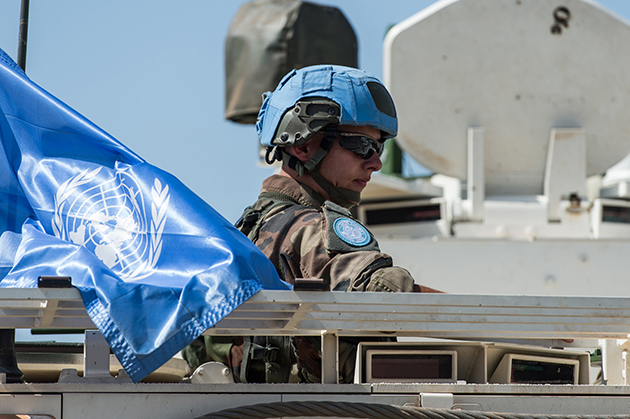
Operation Daman XXI, Deir Kifa camp in southern Lebanon. © JR. Drahi/Armée de Terre
UNIFIL's Force Commander Reserve (FCR), comprised mainly of French soldiers, provides a rapid intervention capability for all the contingents deployed across UNIFIL's zone of action. Thirty officers belong to the UNIFIL command. In summer 2006, while Lebanon underwent a fresh invasion from neighbouring Israel, the UNIFIL mandate was broadened by UN Security Council Resolution 1701. It now included the tasks of monitoring the cessation of hostilities, and accompanying and supporting the Lebanese armed forces.
Among all the members of the UN, France is the 124th contributor of troops (and second among the permanent members of the UN Security Council). France has over 900 soldiers and 30 police officers deployed on nine UN peacekeeping operations (UNIFIL, MINUSMA, MINUSCA, UNOCI, MONUSCO, MINURSO, UNMIL, UNTSO), who occupy many key posts.
Contributing to regional security: Mission Corymbe
In West Africa and the Gulf of Guinea, where France has economic interests and nearly 80 000 French nationals live, there has historically been close cooperation with States of the region. For 27 years, Mission Corymbe has contributed to protecting French interests and French nationals in the region, through a preventive, dissuasive presence.
It completes the pre-positioned French force in West Africa and can also provide support to any operation under way. It is involved in ensuring the security of regional maritime routes by developing cooperation with the local navies, in a regional approach to security.
A French armed forces mission in the Gulf of Guinea in place since 1990, Corymbe involves the near-permanent presence of one to two French navy warships in the area.
Protecting French nationals
In dangerous or unstable security situations, evacuation operations may necessary to protect French nationals.
The situation in Libya in summer 2014 led the French government to request all of its nationals to leave the country. At the same time, the Chief of the General Staff was asked to plan and carry out an operation to enable any French nationals still in the country to leave safely. On the night of 29 to 30 July, the anti-submarine frigate Montcalm and the La Fayette-class frigate (FLF) Courbet conducted an operation to evacuate 47 people, most of whom were French nationals.
Similarly, on 4 and 5 April 2015, on the decision of the French Ministry of Foreign Affairs and International Development, responsible for the safety of French citizens abroad, and in coordination with the Yemeni authorities, the French armed forces evacuated French nationals from Yemen. Three French navy warships (the helicopter carrier Dixmude, FLF Aconit and patroller L'Adroit), a Falcon 50 maritime surveillance aircraft and a detachment of French navy commandos were mobilised to evacuate and bring 109 people, including 39 French nationals, to safety.
Fighting piracy off the coast of Somalia
In December 2008, given the increase in acts of piracy threatening shipping off the coast of Somalia, the European Union launched EUNAVFOR Operation Atalanta, to combat piracy in this strategic area for French and European supplies. Until mid-2013, France had a top-tier frigate and surveillance aircraft engaged permanently, together with reinforcements during the inter-monsoon periods.
The operation resulted in a sharp reduction in acts of piracy. The French contribution was adjusted to concentrate on the inter-monsoon period. The operation is set to go on until December 2018.
Fighting human trafficking off the coast of Libya: EUNAVFOR MED Operation Sophia
On 22 June 2015, the European Union launched EUNAVFOR MED Operation Sophia, to combat human traffickers and smugglers in the Mediterranean. France participated in this mission with the near-permanent deployment of French navy warships in the operation. Regular surveillance flights by Falcon 50s together with satellite observation contributed to the operation's intelligence, while ten French officers were assigned to the operation's command.
Since June 2016, France has been particularly involved in controlling the flow of arms to IS, under the UN resolution determining an embargo on arms to terrorist groups in Libya.
Protecting the borders of Europe and NATO members
In 2013 and 2016, France deployed fighter aircraft as part of the Baltic Air Policing mission. That mission, carried out in turn by the air forces of the NATO member states, sought to guarantee the integrity of the airspace over the Baltic states (Estonia, Latvia and Lithuania).
Saving lives: humanitarian missions
In August 2012, a medical and surgical group was deployed urgently near the Syrian border in Jordan, to provide support to victims of the fighting in Syria and medical assistance to refugees. Under the name Operation Tamour, the detachment was installed at the Zaatari camp on 9 August 2012. Comprising nearly 80 service personnel, it was operational within a week. By November 2013, with the relative stabilisation in refugee numbers and the mobilisation of the international community, the humanitarian situation had improved to the point where the operation could be ended. During its mandate, the medical group carried out 350 major surgical interventions, 22 000 consultations, and 38 000 children under the age of five were vaccinated against measles.
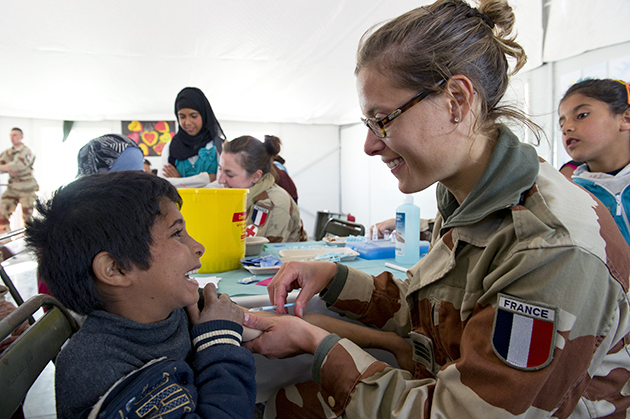
A pharmacist vaccinates a Syrian child at a UNICEF school. © S. Lafargue/ECPAD
In Guinea, in summer 2014, the armed forces took part in France's action to combat the ebola epidemic. Under the name of Operation Tamarin, that contribution involved setting up a treatment centre in Conakry for carers who were in direct contact with the population and might have contracted the virus.
Over nearly six months, the centre, run by a hundred French service personnel, treated 61 carers, 26 of whom had contracted the disease. Their actions helped save 18 of them. By April 2015, the epidemiological situation in Guinea had improved so that a French withdrawal could be considered. The treatment centre was closed on 7 July 2015.
Source: Chief of the General Staff
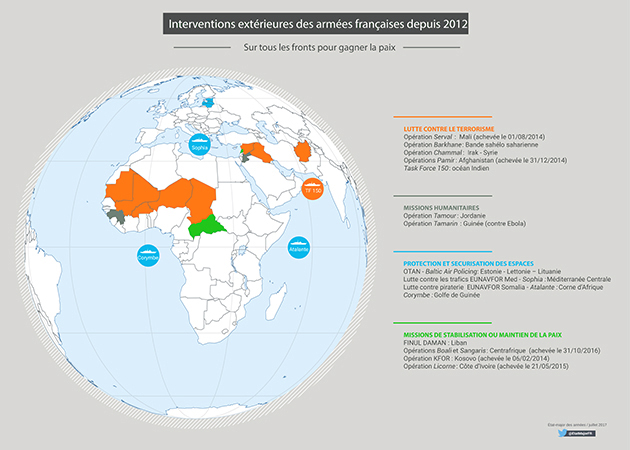
Infographie © EMA
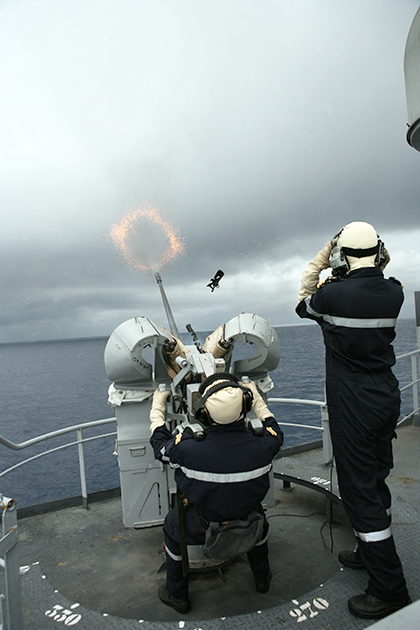
Opération "Atalante". Sur la frégate Floréal. © C. Fiard/DICOD
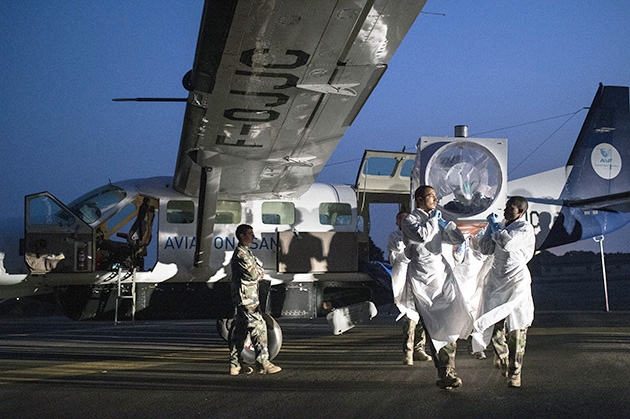
Opération "Tamarin" en Guinée. © A. Roiné/ECPAD

